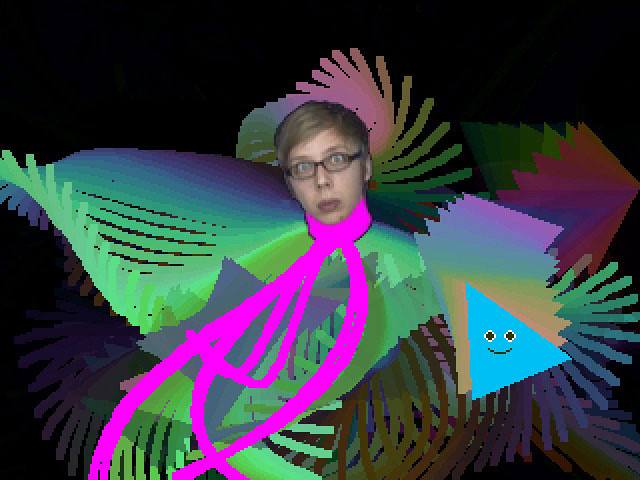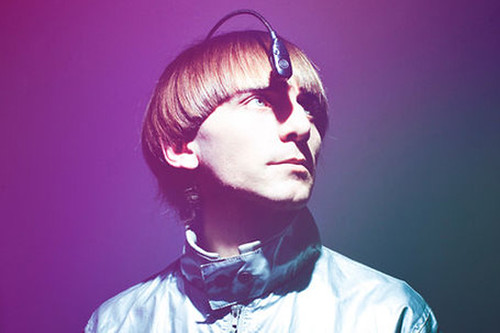“I identify as a unicorn”- queering your augmented reality
Last month, Amsterdam’s new museum for digital art Nxt Museum opened. In one of their first offered activities, you could follow a workshop by Jeremy Bailey in which you were invited to make face filters within the application Lens Studio.
“Choose fabulous looks using the latest tools tips and tricks to augment reality transgress and queer your identity, become a digital unicorn or whatever Nxt you can imagine” (“Digital Drag”).

The world is your canvas
Lens Studio is an application and platform designed for artists, developers, and general social media users to customize face filters and effects. Snapchat launched the developer-tool at the end of 2017, allowing people to try out augmented reality creation (Constine). First, in the form of “world lenses” and later on also applicable to face filters (Crook). Lens Studio is a slightly simplified version of the program that the Snapchat team used to create their augmented reality with. Through templates as “Face Paint” “Trigger”, “Interactive Tap” and “Countdown”, users can modify their face and surroundings in a heartbeat (Crook). When creators have finished their filter and went through the moderation process, they get a “Snapcode” that is valid for a year. This “Snapcode” can be shared via multiple media, varying from social media to print. The creation itself is only usable on Snapchat for 24 hours and therefore concerns repetitive action (Constine).
Besides the creative aspect, Lens Studio was also a smart business move. By giving third parties the option to create their own lenses, Snapchat could fight back against the growing popularity of Facebook and Instagram, and their stories. Although Lens Studio creations can only be shown and used on Snapchat, Instagram users can delve into Facebook’s Spark AR Studio to create their augmented reality. Although Facebook managed to launch their app a few weeks before Snapchat (Constine), it is common knowledge under social media users that Snapchat was the (social media) pioneer with regards to augmented reality, their usage dating back to 2015.

All the different tools available within the program Lens Studio, from face filters to the placement of virtual reality animals in your bedroom, belong to the term “augmented reality”. Augmented reality can be defined as “a real-time direct or indirect view of a physical real-world environment that has been enhanced/augmented by adding virtual computer-generated information to it. AR is both interactive and registered in 3D as well as combines real and virtual objects” (Furht 3). The launch of Lens Studio, and therefore the possibility for users to create augmented reality, already happened in 2017, wherein the beginning mostly professional developers used the program, nowadays the biggest user-demographic is related to general creative social media users (Lynkova). The rapidly growing numbers concerning users (of all kinds) together with the ever-expanding tools urge us to seriously consider the societal consequences of augmented reality.
Transhumanism
The fact that three years after the launch of Lens Studio and Spark AR Studio the world is captivated by augmented reality sparks up different social debates. From teachers who do not understand why their students appear with a dog face in zoom classes, to more serious problems related to “beautifying filters” and their fatal contribution to cosmetic surgery promotion, and societal self-esteem issues (Schipper 25).
But what people might overlook, or see as far-fetched, is the influence of these forms of augmented reality on identity and the self. How big is this influence? The description of the workshop offered by Nxt museum, gives us a playful reminder of a growing, yet unacknowledged “subculture”. The series Years and Years demonstrated a girl who came out to her parents. While the parents prepared a loving monologue expressing the unconditional love for their new son, the girl came out as transhuman. Her first step into this identification: a headset that could project face filters on herself.
Over the years, society became more accepting of people with different gender identities, but when the term transhumanism is dropped, people have a hard time even grasping the concept. So what is transhumanism exactly?
Within the realm of transhumanism, it is crucial to make a distinction between two definitions and uses. In 1990, Max More defined transhumanism as “a class of philosophies of life that seek the continuation and acceleration of the evolution of intelligent life beyond its currently human form and human limitations by means of science and technology, guided by life-promoting principles and values” (More 138). This definition forms a base for transhumanists who seek to enhance their life and their body through implementing technology. The workshop and Years and Years fit within another use of transhumanism, one that relates to human body dysphoria and queerness. The aspect of human body dysphoria is often mentioned within gender identities as “otherkin”: people who identify as non-human (this does not necessarily mean they implement technology), or “technogender ”: only comfortable with one’s gender when using technology/online (Nagle 70). In most cases covered by the media, transhumans do not experience body dysphoria as described within gender identities, but “they believe they can and should improve the human condition through the use of advanced technologies, with as one of the core concepts: life extension” (Anthony).

How far will transhumans go? Caused by body dysphoria or the philosophy that you should always evolve when possible, will they eventually give up their human body? Nowadays technology is not advanced enough to fulfill these aspirations or answer these questions, but their visibility within society is growing. Neil Harbisson, a person with an antenna implanted in his brain is the first legally acknowledged transhuman, based on the visibility of their enhancement on their passport (Darren).
The existence of transhumans, like with other trans identities, comes with transphobia. It can situate itself from the ironic, condescending joke: “I identify as a unicorn” to people being assaulted based on visible technological enhancements (Popper). “We have been augmenting our humanity- our strength, our wisdom, our empathy- with tools since prehistory” (Anthony), so it makes sense that within the rapid technological evolution humans start to identify with the technology, or use it within their personal evolution.
Within the fictional narrative of Years and Years, the use of face filters was projected as a characteristic of transhumanism, but the fictionality should not be underestimated. Together with Jeremy Bailey’s workshop, the number of Lens Studio users demonstrates that there is a growing interest. It is too early to make bold statements concerning the relation between transhumanism and the growing popularity of augmented reality. Nevertheless, we should be respectful to the people that do identify with this identity/philosophy.
References
Anthony, Sebastian. “ What is transhumnism, or, what does it mean to be human?” ExtremeTech, 1 apr. 2013, https://www.extremetech.com/extreme/152240-what-is-transhumanism-or-what-does-it-mean-to-be-human.
Constine, Josh. “Snapchat launches augmented reality developer platform Lens Studio.” TechCrunch, 14 dec. 2017, https://techcrunch.com/2017/12/14/snapchat-developer-platform/.
Crook, Jordan. “Snap launches new features for Lens Studio.” TechCrunch, 17 apr. 2018, https://techcrunch.com/2017/12/14/snapchat-developer-platform/.
Darren, Allan. “Cyborg activist Neil Harbisson wins battle to have ‘eyeborg’ on passport photo.” ItProportal, 11.nov, 2014, https://www.itproportal.com/2014/11/11/cyborg-activist-neil-harbisson-wins-battle-to-have-eyeborg-on-passport-photo/
Fig. 1. Source link: https://search.creativecommons.org/photos/17b85812-5d09-4e0b-ba43-59d79edb6ab8
Fig. 2. Source link: https://search.creativecommons.org/photos/4c083701-a42e-4df9-bcca-5be6091a613b
Fig. 3. Source link: https://search.creativecommons.org/photos/7f007b36-1a85-4947-8b3c-c8667338affc
Furht, Borko, ed. Handbook of augmented reality. Springer Science & Business Media, 2011.
Lynkova, Darina. “ 29+ Augmented reality statistics” Leftronic, 30 oct. 2019, https://leftronic.com/augmented-reality-statistics/#:~:text=An%20eMarketer%20study%20suggests%2068.7,eMarketer’s%20AR%20and%20VR%20statistics.
More, M. (2010). True transhumanism. Edited by Gregory R. Hansell and William Grassie, 136.
Nagle, Angela. Kill all normies: Online culture wars from 4chan and Tumblr to Trump and the alt-right. John Hunt Publishing, 2017.
Popper, Ben. “New evidence emerged in alleged assault on cyborg at Paris McDonald’s” TheVerge, 19 jul. 20, https://www.itproportal.com/2014/11/11/cyborg-activist-neil-harbisson-wins-battle-to-have-eyeborg-on-passport-photo/.
Schipper, Meike. ” A whole new way to see yourself (ie)”: Exploring how face filters transform the practice of selfie creation. MS thesis. 2018.